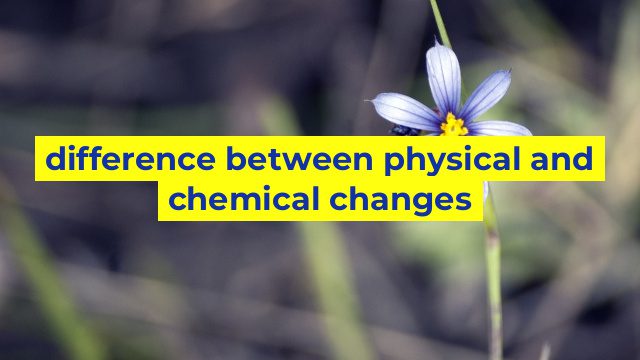Difference between Physical and Chemical Changes
Physical and chemical changes are two main types of changes that can occur in matter. Understanding the difference between the two can be helpful in various fields such as chemistry, biology, and other sciences. In this article, we will discuss the main differences between physical and chemical changes.
Physical Changes
Physical changes involve a change in the physical properties of a substance without a change in its chemical composition. In other words, the substance remains the same, but some properties of it may be altered. For instance, ice melting into water is an example of a physical change. During this change, the ice changes its state from a solid to a liquid, but it still remains water. Other examples of physical changes include boiling water to form steam, breaking a glass, and melting wax.
Chemical Changes
Chemical changes, on the other hand, involve the formation of a new substance by altering its chemical composition. This usually occurs due to the rearrangement of atoms in molecules in such a way that they form a completely different compound. For instance, burning wood is an example of a chemical change. During this process, the wood reacts with oxygen to form carbon dioxide and water vapor. Other examples of chemical changes include rusting of iron, cooking food, and digestion of food in the body.
Difference between Physical and Chemical Changes
The main difference between physical and chemical changes is the change in the chemical composition of the substance. In physical changes, the substance remains the same, while in chemical changes, the substance changes entirely. Another difference is that physical changes are usually reversible, while chemical changes are often irreversible. For example, heating a metal may change its shape, but it can be reshaped without changing its chemical composition. But when an egg is cooked, it cannot be returned to its previous form.
In conclusion, physical and chemical changes are both vital phenomena that occur in matter. Understanding the differences between them can be helpful to scientists, students, and anyone interested in the observable world. Physical changes are mainly concerned with the physical properties of a substance, while chemical changes involve a change in its chemical composition. Moreover, physical changes are usually reversible, while chemical changes are frequently irreversible.
Table difference between physical and chemical changes
Here is an example of an HTML table that highlights the differences between physical and chemical changes:
| Physical Changes | Chemical Changes |
|---|---|
| Do not change the identity of the substance | Change the identity of the substance |
| May involve changes in state or shape | May involve formation of new substances |
| Reversible, meaning the change can be undone | Irreversible, meaning the change cannot be undone |
| Cannot release or absorb energy | Can release or absorb energy |
| May involve changes in physical properties such as color, texture, or odor | May involve changes in chemical properties such as reactivity or flammability |
